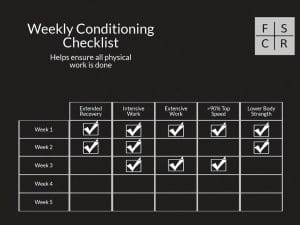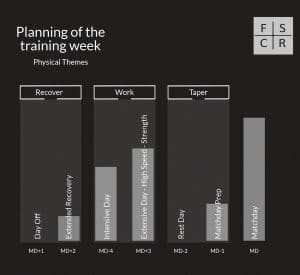The term tactical periodization gets used regularly these days when talking about training within football, and it is a theory that aims to address all forms of tactical, technical and physical work within a training week (1).
Although hugely popular across Europe, there are occasions in which the physical elements can get blurred within the tactical and technical focused sessions, and each day can look similar from a physical point of view.
Within tactical periodization, terms often used relating to the physical components are ‘strength’, ‘resistance’, ‘speed’ and ‘activation’, with each day throughout the week aiming to have a physical aim as well as a tactical focus.
Given that we want the first 48hrs post-match to have a recovery focus, and the 48hrs before our next game to be tapered down from a physical perspective, our only real days available to train well throughout the week are Tuesday and Wednesday (in a typical Saturday-Saturday week).
As players, we can change these terms and themes slightly to make it easier to understand and implement. Instead of ‘strength’, ‘tension’ or ‘resistance’, how about using the terms ‘intensive’ and ‘extensive’?
Intensive work refers to training within small areas, with small numbers of players. We’ll see a high number of accelerations and decelerations, and also spikes in your heart rate as you are having to maintain a high work rate for a set period of time (2). Examples of Intensive drills include 2v2 – 4v4 small sided games, and short, repeated efforts over smaller distances.
Extensive work focuses on much bigger spaces, with the idea of increasing distances covered, particularly at higher speeds (3). Typical drills that cover the extensive part of the week include 8v8 – 10v10 on larger pitches, counter attacking drills in which players are having to recover into position at speed, and also repeated high speed efforts over 30-40m. This day can also be termed the ‘tactical conditioning day’, as it is often then day in which coaches get the majority of their tactical messages across.
There is sufficient evidence available that supports the idea that being exposed to high speeds throughout the week (at the right time!) help to prepare players for match play, and reduce the risk of injuries by being under-prepared (4). This extensive day is the perfect time to hit >90% of your top speed, so a small amount of high-speed runs should help achieve this (2-3 efforts over 30m for example).
The final part of your week that needs to be achieved from a physical perspective is fitting your lower-body strength work in and around your on-pitch training. People have different opinions and ideas regarding when this should be done, although if we’re looking to overload our muscles and drive adaptation, then the safest time is after our extensive training day to ensure that we aren’t entering our toughest football session of the week in an already-fatigued state (5).
An easy way to keep tabs on what you have ticked off and what still needs to be done throughout the week is to use something that I call the ‘Conditioning Checklist’. It’s just simply a list of the 5 key variables that we need to hit from a purely physical perspective. It won’t always be possible to achieve all variables during every week, particularly when we add in midweek fixtures, but it helps us to keep tabs on where we are at ahead of our next game.
- Extended Recovery (following the previous game)
- Intensive Work
- Extensive Work
- Achieve >90% top speed
- Lower-Body Strength

By the time you get to the day before a game, each player will normally have their own individual routines that they like to tick off, normally from a mental aspect than anything overly performance related. However, adding in some quick, reactive movements over short distances can act as a ‘primer’ heading into the match the following day.
References
- Martins, F. The tactical periodization according to Vitor Fradé. More than a concept, a way of being and reflecting football (thesis). University of Porto, Porto, 2003.
- Impellizzeri, F. M., Marcora, S. M., Castagna, C., Reilly, T., Sassi, A., Iaia, F. M. & Rampinini, E. Physiological and performance effects of generic versus specific Aerobic Training in Soccer Players. International Journal of Sports Medicine, 2006.
- Owen, A. L., Wong, D. P., Paul, D. & Dellal, A. Physical and technical comparisons between various-sided games within professional soccer. International Journal of Sports Medicine, 35, 2014.
- Malone, S., Roe, M., Doran, D., Gabbett, T. & Collins, K. High chronic training loads and exposure to bouts of maximal velocity running reduce injury risk in elite Gaelic football. Journal of Science and Medicine in Sport, 2017.
- Lovell, R., Siegler, J. C., Knox, M., Brennan, S. & Marshall, P. W. M. Acute neuromuscular and performance responses to Nordic hamstring exercises completed before or after football training. Journal of Sports Sciences, 34, 2016.

